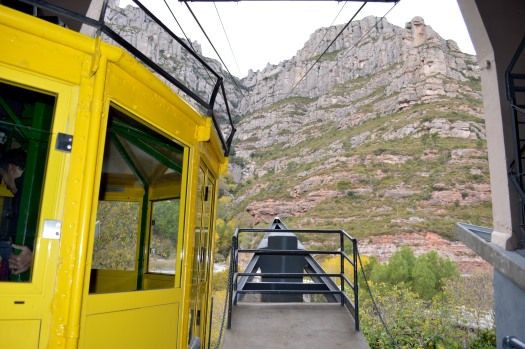Montserrat
Nov 16th, 2013 by willmarks
Montserrat is 48 km west of Barcelona and, while only 4,055 feet high, the mountain really stands out with nothing like it in the vicinity. The name Montserrat means “serrated mountain,” and one look at it makes you understand why. We have driven by and looked up a few times, on ventures to San Sebastian and Madrid, and visiting Montserrat was certainly a planned activity during our Spanish conquest.
On Friday, Max was very content to head off to school, alone for the first time here. Tired of travel, he was pleased to miss our excursion on a day when the girls had a break for parent-teacher conferences.
We journeyed with our friends the Nelsons (their daughters match up in age with ours) on the one-hour train ride from Barcelona. A short walk from the train station put us at the 1930 vintage Montserrat cable car, on which we ascended the mountain during a steep 5 minute climb to 2,400 feet. This is a smaller and much older version of the Squaw Valley cable car, and the voyage itself may have been the day’s highlight for the youth, a rapid ride in a small old cabin hanging from a narrow cable seemingly 1,000 feet above ground.
This left us at the monastery, but an additional funicular upward allowed for even more breathtaking views of the Mediterranean and Barcelona surroundings from 4,000 feet, not to mention a discussion of the lifestyle of hermits, who were but are no longer present on Montserrat. The funicular also gave us the opportunity for necessary exercise with an almost complaint free 30 minute descent back to the monastery. Here we entered the basilica for the 1:00 p.m. boys’ choir performance.
The basilica was built in the 1850’s. From a distance inside the church (above the singing boys), we could see La Moreneta, the small wood statue of the so called Black Virgin (translation is “Tanned Virgin”) that was discovered in “the Sacred Cave” in the 12th century, and allegedly carved by St Luke. Full disclosure: we truly had a limited view of La Moreneta, which to some purists would be similar to visiting the Sistine Chapel and failing to stare at the ceiling.
In terms of history of the monastery, hermit monks apparently began building chapels here in the 9th century, with the monastery officially founded in 1025, and the first record of a boys’ choir here in 1223 (oldest children’s music school in Europe we are told). Word spread, even to America, as one Montserrat hermit joined Christopher Columbus on his voyage, and this became a popular pigrimage stop. In 1811-1812, Montserrat was devastated by Napoleon’s army, and later the monastery was down to one monk (after the 1835 Land Acts left it without property); but in the middle of the 19th century, the monks began returning and Montserrat was rebuilt. The 1936-1939 civil war and the Franco years were not good to Montserrat but the Catalonian government protected it like a baby.
 There are about one hundred monks who are based at Montserrat Monastery, and they follow the Order of St. Benedict. According to the Montserrat tourist guide, “their life is devoted to prayer and work…the Monks can be distinguished from other orders of Monks by their philosophy that there is an importance to everything that every person is.”
There are about one hundred monks who are based at Montserrat Monastery, and they follow the Order of St. Benedict. According to the Montserrat tourist guide, “their life is devoted to prayer and work…the Monks can be distinguished from other orders of Monks by their philosophy that there is an importance to everything that every person is.”




I have always wanted to venture into Montserrat as I have heard that the monastery as well as the monks are fascinating. Even though, I wish I was right there alongside EEM, it is fun living Spain through your site!
ps… Max is all growed up now – going to school on his own!
I am loving “being on this trip” with you through Will ‘s charming descriptions.
Thank you for reading the blog; it is certainly one long trip.